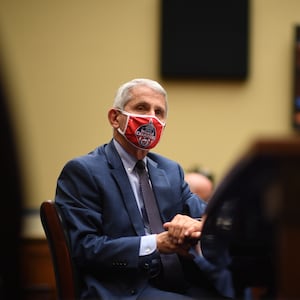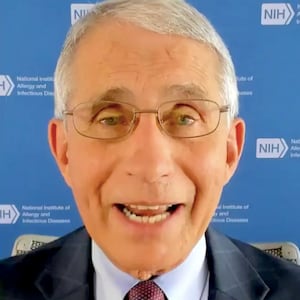In recent weeks, President Donald Trump has boasted about his administration’s efforts to produce a safe COVID-19 vaccine while simultaneously declaring that the distribution of that vaccine to the American public would happen “very soon.”
But Trump has not seen the vaccine data.
In fact, no one in the administration has seen it. In an interview with The Daily Beast Monday evening, Dr. Anthony Fauci, the head of the National Institute of Allergy and Infectious Diseases, said there is only one individual who has access to the data that would show whether a vaccine is viable.
ADVERTISEMENT
“These are blind placebo-controlled trials. The only ones who see the data intermittently is the safety data monitoring board…. a single unblinded statistician,” Fauci said. “Those data are not public data, no one can know what those data show. That person looks at the data and says, ‘OK, let's keep the trial going, we don't have enough data to make a decision.’ Or that person can look at the data and say, ‘You know, there really is a very strong signal of efficacy, let's make it known.’ We bring in the company, we tell the company, then the company can make up their mind, whether they want to use that data to go to the [Federal Drug Administration for approval].”
In other words, Fauci said, there is no way of knowing how the U.S. is faring in its development of a vaccine until a subset of statisticians decide it’s time for it to be known. The fact that the data is so closely held is part of what is supposed to build trust in the science community and within the administration that the vaccine was developed in a controlled environment without political influences.
Fauci has previously said that he would “bet” on a November or December timeline for learning the efficacy of a vaccine—not necessarily for guaranteeing its distribution. (A vaccine would need to get approved by the FDA before distribution to the military, nursing homes, and other vulnerable populations). And last week President Trump himself walked back part of his promise of a quick vaccine delivery, saying the U.S. was on target to manufacture enough vaccines to distribute to Americans by April 2021, not by October 2020, as he’s suggested. But despite that correction, the president has continued to stand at the White House press podium, proclaiming to reporters and Americans watching at home that a successful vaccine is inevitable and that data shows the vaccine development is in its final stage.
“We essentially have it,” Trump said at a news conference last Friday.
Trump’s proclamations have fed into a growing level of uneasiness about the efficacy of the vaccine approval process, creating additional complications for his own coronavirus task force. Both Fauci and fellow task force members have continued to press privately the importance of building trust among the American people that when a vaccine is produced it will have gone through a rigorous review process.
The dichotomy between the president’s public hyping of the vaccine and the reality that no one in the Trump administration knows what the data actually says underscores the problem the federal government faces in tackling this growing public relations problem.
“The lack of trust in a vaccine is multifaceted,” Fauci said. “Even if there weren't any mixed signals coming out of the government, there still would be a bit of an anti-vaxx feeling. You superimpose a part of that... the kind of mixed signals that are coming out of different agencies, people read that in the newspaper, whether it's real or not, and they get concerned... can you believe what the government says?”
The mixed messaging from the government is not just around the production of a vaccine. Testing and other community health guidelines have stirred tensions among officials working with the task force.
The Centers for Disease Control and Prevention last week quietly updated its guidelines on COVID-19 transmission, saying “airborne viruses, including COVID-19, are among the most contagious and easily spread” and that the virus could spread "through respiratory droplets or small particles, such as those in aerosols, produced when an infected person coughs, sneezes, sings, talks or breathes." On Monday, however, the agency took down its guidance, telling reporters the website had been altered by accident and that the information previously published was still under internal review. An hour later, the CDC took it a step further, saying the information posted on its website “does not reflect” its “current state of knowledge”.
That redaction was merely the latest misstep made by CDC officials. Last week the agency again revised its testing guidelines, telling Americans that individuals without coronavirus symptoms should be tested “due to the significance of asymptomatic and pre-symptomatic transmission.” The CDC had put out guidelines in August that said individuals who were not exhibiting COVID-related symptoms “do not necessarily need a test.” The New York Times reported that top officials at the Department of Health and Human Services and the White House coronavirus task force had finalized the August testing guidelines and “dropped” them onto the CDC’s website without approval of the agency.
As the COVID-19 death toll in the U.S. nears 200,000, an increasing number of cases are emerging in Wisconsin, North Dakota and Utah, including within communities on college campuses. Meanwhile, in the White House, President Trump’s closest advisers have continued to downplay the threat and complications that come with reopening restaurants, gyms, bars and schools. On Monday Trump’s economic adviser Larry Kudlow told reporters that the U.S has “regained control of the virus.” But scientists working with the White House coronavirus task force, including Fauci, continue to warn that large indoor gatherings carry heavy risks, particularly because liquid droplets from speaking or breathing can infect individuals if there is a lack of airflow.
Now that cases are rising on university campuses, Fauci said he and Dr. Deborah Birx, the coordinator of the White House task force, developed a plan to keep students on campus and separated from other students if they are infected. Birx raised the idea on a call with the nation’s governors earlier this month. And Fauci seconded it in Monday’s interview, stressing that schools should keep infected students on campus even during the Thanksgiving break.
“If you want to get the kids back to college, and some may inevitably get infected, you've got to do two things. You've got to be able to segregate them from the student body so they don't infect the whole student body. So you got to have the capability of putting them safely and comfortably, since most of them will be eating without symptoms, mild symptoms, put them in a... in a special dormitory,” Fauci said, adding that schools should at the same time be surveilling those students who do not present with symptoms but may have come into contact with a COVID19 positive classmate.
“Then, importantly, we should not send them home,” Fauci added. “They may be infected and not particularly sick or not particularly impacted by the infection. But they go back and then grandma and grandpa and uncle or aunt or mother, who’s a compromised host with diabetes, or obesity or what have you, that’s when you get into real trouble.”
Fauci warned against colleges and universities continuing to let coronavirus-positive students live among the rest of the campus, saying the country should have learned its lesson from the summer when Americans went back to restaurants and bars and did not adhere to the public health guidelines.
“It's the same thing that, you know... at the the holidays, we had Fourth of July, Memorial Day, people felt pent-up, they went to the bars, they got infected, maybe they didn't really get much symptoms. But then they went back into the community and transmitted it to vulnerable people,” Fauci said, pointing to early reopening and a lack of proper social distancing and mask wearing as catalysts for community spread.
“That's the reason why we saw the sharp increase in cases and hospitalizations, and deaths,” Fauci said.
Fauci has previously said that he wanted to see the U.S. at 10,000 cases by the time the fall semester started—about 30,000 fewer cases than the U.S. is currently clocking on an average daily basis. That doesn’t sit well with the nation’s leading vaccine official.
“I’ve been saying this a lot. I sound like a broken record. We are still nowhere near that threshold that I laid out earlier,” Fauci said, adding that if people continue to push back on social distancing and mask wearing guidelines, particularly when indoors, the country could see another wave. “We will have to see what happens when the winter comes and people are forced inside.”








